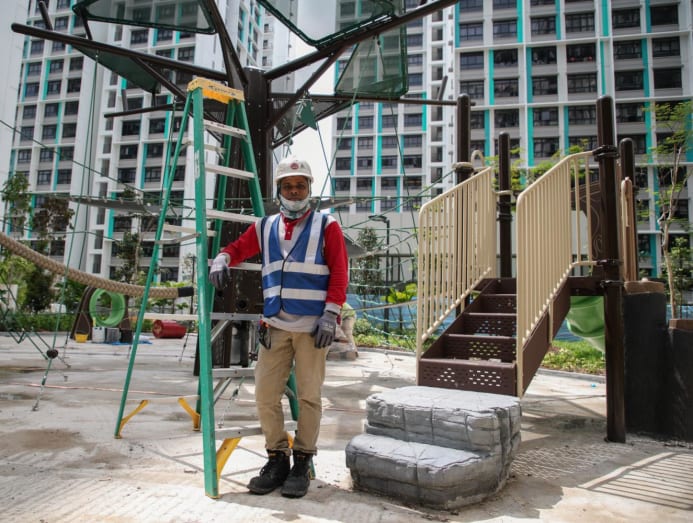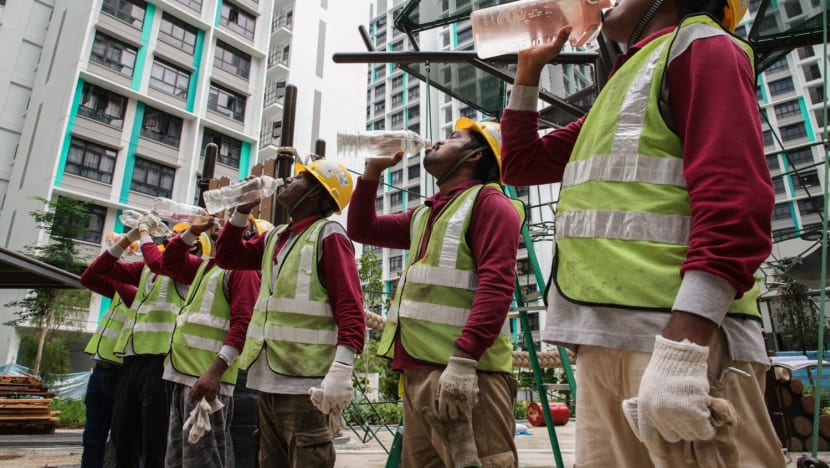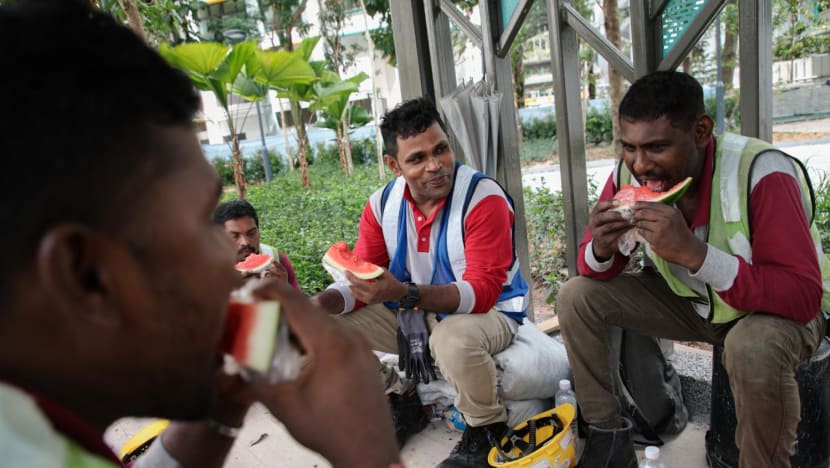Can't stand the erratic weather? Here's what it's like working outdoors when it's scorching one day, pouring the next
SINGAPORE — While many may welcome the past few days of break from the heat wave, for outdoor workers like Mr Mathiyalagan Karthikeyan, the recent spell of sudden showers is a disruption to his daily routine.
For the 43-year-old migrant worker, rising early and being under the sun for eight hours is part of his daily grind.
Nine of his 14 years in Singapore have been spent working for Ct-Art Creation, where he has helped to build more than 100 playgrounds in housing estates, parks and shopping centres.
Mr Karthikeyan is one of the workers on the frontlines of Singapore's increasingly extreme weather.
Last year, the highest recorded temperature was a scorching 37°C in May, with 2023 also the fourth hottest year on record since 1929.
In October last year, the Ministry of Manpower introduced new rules, including mandatory hourly breaks when the weather is above 32°C, to protect outdoor workers from heat stress.
While wetter weather has been forecast for April, the Meteorological Service Singapore said daily maximum temperatures may range between 34°C and 35°C on most days.
To get a better sense of how outdoor workers adapt to the increasingly extreme weather, TODAY accompanied Mr Karthikeyan for a day on the job and learnt his tips for keeping cool.
AT HOME IN THE HEAT
Decked in a bright blue vest and white helmet, he led a team of six workers tasked to put the finishing touches on a treehouse-themed playground set in Geylang on Thursday (April 11).
But first, they had their first “water parade” of the day, where all the workers drank from their water bottles.
The day had started with a light drizzle and by 10.30am, it had become cloudy with the temperature at 29°C. For Mr Karthikeyan, it was a pleasant start to the day.
“The place we came from is hotter than here, so for us, it’s just normal,” he said.

Most of the workers are from India, where temperatures can rise to as high as 42°C during dry seasons.
So as I wilted in my short-sleeved shirt which had become damp due to the humidity, Mr Karthikeyan was going around inspecting the unfinished parts of the playground without much fuss.
To them, the cloudy weather was a nice reprieve from the earlier days in the week where temperatures hit close to 35°C in the day.
“Last two weeks... very hot. When we hear the news that Singapore is getting hotter because of El Nino, we were all prepared,” said Mr Karthikeyan.
But he has heard of other outdoor workers who had suffered from heat stress, especially those who worked in less shaded areas.
The playground project in Geylang is surrounded on all sides by finished blocks of Build-to-Order flats, which provide cover from the sun.
“When we go to the new sites, there is no building, it’s totally open space, so there is no shade for the whole day,” said Mr Karthikeyan, who recalled one park playground site that was “very open”.
Soon it was time for another water break. They do this every hour, Mr Karthikeyan calling the workers together and cajoling them to “drink more”.
“Some of them don’t like to drink water. I don’t think everyone is used to drinking more water every day and they don’t know if (what they drink) is enough or not,” he said.
As a team lead, he has to take photos of their water parades and send them to his bosses as proof that they are adhering to this safety regulation.



DEALING WITH UNPREDICTABLE WEATHER
Much of the playground in Geylang were already in place, so the team just had to clean up the debris, attach the remaining screws and accessories, and then do the flooring.
The weather, however, had other ideas.
Just over an hour after the team started work, it began to pour — lightly at first, before it became a deluge.
Mr Karthikeyan said the fluctuating weather is different from what he experienced in his home state of Tamil Nadu in India.
“Back home it’s not like this, we have seasons. When it’s rainy season, it’s two, three months always raining, sometimes with typhoons… In Singapore, it’s 50-50, hot and cold,” he said.
He uses an application on his phone to check the weather across Singapore, which allows him to assess if he and his men should head to another site.
With work interrupted by the rain, Mr Karthikeyan and his team took an early lunch at around 11.30am. While heat stress is always a concern, he is clear when I asked if he would rather it rain.
“No. If it’s raining, then we need to work overtime if you want to follow the schedule. If (it’s) raining (and workers) work outdoors, they will get sick because it is cold then very hot. Then the next day they take MC.”
While the workers are equipped with ponchos, Mr Karthikeyan said that they are used only during light rain. For safety, work grinds to a halt during heavier downpours or when there is a lightning alert.
“Everyone prefers the whole day having the same weather so you can finish up your work fast, go back home and rest and do whatever you like,” said Mr Karthikeyan.
“Now we see it’s sunny, cloudy, rainy. No one can predict the weather here.”
Mr Karthikeyan is prepared for all eventualities; he has in his bag a fresh set of clothes to change into after working up a sweat or being caught in the rain.
Gloves are also essential to protect workers’ hands from getting burnt, as their tools and the playgrounds can become hot to the touch by the afternoon after being exposed to the sun.
Mr Karthikeyan showed me his tricks for keeping cool. He would wear a long-sleeved cotton shirt and a hat under his helmet to protect from the sun’s glare on hotter days.
What he eats also matters.
As a sweet treat and means to beat the heat, he has arranged for slices of watermelon for the workers’ tea break at 3pm.
“For those who want to work outside, make sure to wear fully covered clothes, drink plenty of water. Eat some fruits, like papaya, watermelon — not durian,” he advised with a smile.









